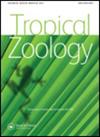Small mammal assemblages and their ectoparasite prevalence (Acarina) in mangrove forests of Peninsular Malaysia
IF 0.7
4区 生物学
Q4 ZOOLOGY
引用次数: 5
Abstract
The mangrove forest is located in the coastal intertidal zone and plays a vital role in buffering against erosion from storm surges, currents, waves, and tides. This ecosystem also serves for ecotourism due to its heterogeneous habitats, which supported a high diversity of plants and animals. Small mammals are among the abundant but poorly recognised inhabitants in mangrove forests. Apart from their role as primary consumer and prey, they are host to various ectoparasites, which potentially become the primary vector for tick-borne diseases among visitors. Therefore, this study aims to determine the small mammal assemblages and their ectoparasite prevalence in mangroves forests of Peninsular Malaysia. The capture-release method was applied for small mammal sampling, and each captured individual was screened and collected for ectoparasites before released. DNA barcoding using CO1 genes was performed for small mammal species verification, whereby ectoparasite identification was based on morphological identification and molecular verification using 16S rDNA genes. A total of 94 small mammals from 6 species were captured across sites, dominated by Rattus tiomanicus (n=74). From this number, 15 individuals (16% prevalence) were infested by ticks, 22 individuals (23%) were infested by mites, whereas 4 individuals (4%) were infested by both ticks and mites. Five species of ticks and one mite species were identified; Amblyomma cordiferum, Ixodes granulatus, Haemaphysalis hystricis, Dermacentor auratus, Dermacentor atrosignatus, and Laelaps echidninus. This study reveals a relatively poor diversity of small mammals in the mangroves forest, of which highly infested with a diversity of ectoparasites, elucidating the relationship of hostectoparasite associations in the riparian zone. This information is crucial to inform visitors to these areas, ultimately safeguard against ectoparasite-borne disease.马来西亚半岛红树林中小型哺乳动物群落及其体外寄生虫的流行(Acarina)
红树林位于沿海潮间带,在缓冲风暴潮、洋流、海浪和潮汐的侵蚀方面发挥着至关重要的作用。这种生态系统也有利于生态旅游,因为它的异质栖息地支持了植物和动物的高度多样性。小型哺乳动物是红树林中数量丰富但鲜为人知的居民之一。除了作为主要消费者和猎物外,它们还是各种体外寄生虫的宿主,这些寄生虫可能成为游客中蜱传疾病的主要媒介。因此,本研究旨在确定马来西亚半岛红树林中小型哺乳动物的群落及其体外寄生虫的流行情况。捕获-释放方法用于小型哺乳动物采样,每个捕获的个体在释放前都要进行体外寄生虫筛查和收集。使用CO1基因的DNA条形码用于小型哺乳动物物种的验证,其中体外寄生虫的鉴定基于形态学鉴定和使用16S rDNA基因的分子验证。共有来自6个物种的94种小型哺乳动物在不同地点被捕获,其中以鼠(Rattus tiomanicus,n=74)为主。从这个数字来看,15个人(16%的患病率)受到蜱虫的侵扰,22个人(23%)受到螨虫的侵扰;而4个人(4%)同时受到蜱虫和螨虫的侵袭。鉴定出5种蜱和1种螨;黄颡鱼、颗粒硬蜱、牛血蜱、auratus Dermacentor atrosignatus和针叶树。这项研究揭示了红树林中小型哺乳动物的多样性相对较差,其中体外寄生虫的多样性很高,阐明了河岸带宿主寄生虫协会之间的关系。这些信息对于告知这些地区的游客,最终预防体外寄生虫传播的疾病至关重要。
本文章由计算机程序翻译,如有差异,请以英文原文为准。
求助全文
约1分钟内获得全文
求助全文
来源期刊

Tropical Zoology
生物-动物学
CiteScore
2.50
自引率
0.00%
发文量
1
审稿时长
>12 weeks
期刊介绍:
Tropical Zoology is an international zoological journal publishing original papers in the field of systematics, biogeography, phylogeny, ecology and conservation of all terrestrial and aquatic animal Phyla from tropical and subtropical areas.
Only papers with new information, high quality and broad interest are considered. Single species description and checklists are not normally accepted. Review papers are welcome. The journal is owned by the Istituto di Ricerca sugli Ecosistemi Terrestri of the Consiglio Nazionale delle Ricerche, Florence, Italy (CNR-IRET) who performs research into the structure and functioning of aquatic and terrestrial ecosystems, focusing in particular on anthropogenic pressure and global change. The knowledge amassed forms the scientific basis for identifying the most appropriate protective and corrective interventions, and provides support for the bodies entrusted with formulating policies for environmental protection and recovery.
 求助内容:
求助内容: 应助结果提醒方式:
应助结果提醒方式:


